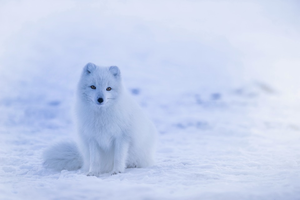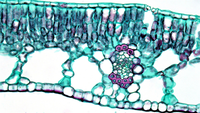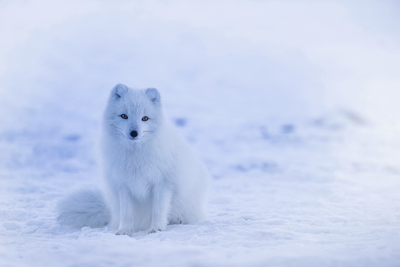Key Stage 2
Meaning
An adaptation is a special part a living creature has that helps it survive. Sometimes an adaptation is the shape or size of certain parts of the creature.
- Singular Noun: Adaptation
- Plural Noun: Adaptations
- Verb: To adapt
- Adjective: Adapted
About Adaptations
- Adaptations allow organisms to survive in their habitats.
- Adaptations are caused by evolution.
Adaptations for the Arctic and Antarctic
|
|
The polar bear is adapted because it has thick fur to stay warm and it has white fur to camouflage in the snow.
|
|
|
The arctic fox is well adapted to the arctic with thick fluffy white fur.
|
|
|
An adaptation of penguins is thick fluffy feathers to keep warm. Penguins do not need to be camouflaged with white feathers because there are few predators to hunt them.
|
|
|
|
|
| The polar bear is adapted because it has thick fur to stay warm and it has white fur to camouflage in the snow.
|
The arctic fox is well adapted to the arctic with thick fluffy white fur.
|
An adaptation of penguins is thick fluffy feathers to keep warm. Penguins do not need to be camouflaged with white feathers because there are few predators to hunt them.
|
Adaptations for deserts
|
|
|
|
| The cactus has evolved the adaptation of not having any leaves. This stops them from losing water too quickly in the dry desert.
|
An adaptation of camels for the desert is the hump on their back which stores food because there is not much to eat in the desert.
|
The desert fox has been adapted to have very large ears to help them cool down when it is hot.
|
Adaptations for Defence
|
|
|
|
| Hedgehogs have spikes. This adaptation make it difficult for animals to eat them.
|
Cactus plants have spikes. This adaptation make it difficult for animals to eat them.
|
Octopuses and squid spray ink when they are being attacked. This adaptation makes it difficult for the predator to see them when the swim away.
|
Key Stage 3
Meaning
An adaptation is a special part an organism has that helps it survive in its habitat. Sometimes an adaptation is the shape or size of certain parts of the organism.
Adaptations of Animals
|
|
|
|
| The polar bear is adapted because it has thick fur to stay warm and it has white fur to camouflage in the snow.
|
An adaptation of camels for the desert is the hump on their back which stores food because there is not much to eat in the desert.
|
Hedgehogs have spikes. This adaptation make it difficult for animals to eat them.
|
Adaptations of Plants
|
|
|
|
| The cactus has evolved the adaptation of not having any leaves. This stops them from losing water too quickly in the dry desert.
|
An adaptation of the leaf is the air gaps that allow the exchange of gases needed for photosynthesis and respiration.
|
An adaptation of many plants is to have hard seeds which are shells which protect the offspring from being eaten as well as from cold or dry conditions allowing the offspring to wait for the conditions to be just right before germinating.
|
Adaptations of Specialised Cells
Key Stage 4
Meaning
Adaptations are features of an organism that help it survive within its ecosystem or features of specialised cells which allow them to perform a specific job within an organism.
About Adaptations
- Adaptations evolve over many generations.
Examples
|
|
|
Adaptations of the desert fox:
- Thin fur - Allows it to cool down more quickly.
- Large ears - Allow the fox to lose thermal energy through blood vessels in the ears.
- Large surface area compared to volume - Provides a greater area for thermal energy to escape.
- Nocturnal - The desert fox sleeps during the day and comes out at night when it is cooler.
- Sand coloured fur - To camouflage the desert fox when it is hunting.
|
Adaptations of the arctic fox:
- Thick fur - Insulates the fox to keep warm.
- Small ears - To prevent the loss of thermal energy through blood vessels in the ears.
- Small surface area compared to volume - The rounded shape provides a smaller area for thermal energy to escape.
- White coloured fur - To camouflage the desert fox when it is hunting.
|
References
AQA
- Adaptation; behaviour, pages 338-9, GCSE Biology; Student Book, Collins, AQA
- Adaptation; camouflage, pages 338, GCSE Biology; Student Book, Collins, AQA
- Adaptation; cell, pages 26-7, 60-1, GCSE Biology; Student Book, Collins, AQA
- Adaptation; functional, page 339, GCSE Biology; Student Book, Collins, AQA
- Adaptation; organ, 100-1, GCSE Biology; Student Book, Collins, AQA
- Adaptation; organisms, pages 54, 322-3, 338-9, GCSE Biology; Student Book, Collins, AQA
- Adaptation; structural, pages 339-41, GCSE Biology; Student Book, Collins, AQA
- Adaptations, page 108, GCSE Biology; The Revision Guide, CGP, AQA
- Adaptations, page 85, GCSE Combined Science; The Revision Guide, CGP, AQA
- Adaptations, pages 242-5, 248-9, GCSE Biology, Hodder, AQA
- Adaptations, pages 261, 262, GCSE Combined Science Trilogy; Biology, CGP, AQA
- Adaptations, pages 321, 322, GCSE Biology, CGP, AQA
- Adaptations, pages 74, 81-2, GCSE Combined Science Trilogy 2, Hodder, AQA
- Adaptations; cell specialisations, pages 8-10, GCSE Combined Science Trilogy 1, Hodder, AQA
- Adaptations; facilitation of diffusion, pages 31, 33, GCSE Combined Science Trilogy 1, Hodder, AQA
- Adaptations; To extreme environments, pages 82-3, GCSE Combined Science Trilogy 2, Hodder, AQA
Edexcel
- Adaptations, pages 8, 126, GCSE Combined Science, Pearson Edexcel
- Adaptations, pages 8, 180, GCSE Biology, Pearson, Edexcel


















